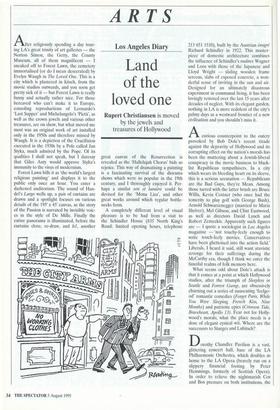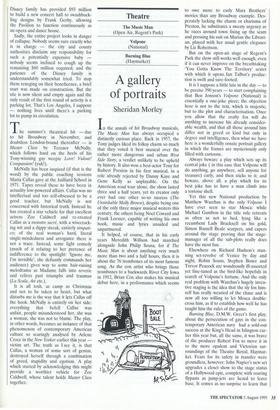ARTS Los Angeles Diary
Land of the loved one
Rupert Christiansen is moved by the jewels and treasures of Hollywood After religiously spending a day tour- ing LA's great trinity of art galleries — the Norton Simon, the Getty, the County Museum, all of them magnificent — I sneaked off to Forest Lawn, the cemetery immortalised (or do I mean desecrated) by Evelyn Waugh in The Loved One. This is a city which is plastered in kitsch, from the movie studios outwards, and you soon get pretty sick of it — but Forest Lawn is really funny and actually rather nice. For those bereaved who can't make it to Europe, consoling reproductions of Leonardo's 'Last Supper' and Michelangelo's 'Pieta', as well as the crown jewels and various other treasures, are on show, but what moved me most was an original work of art installed only in the 1950s and therefore missed by Waugh. It is a depiction of the Crucifixion executed in the 1930s by a Pole called Jan Styka, much admired by the Pope. Of its qualities I shall not speak, but I daresay that Giles Auty would approve Styka's immunity to the virus of modernism.
Forest Lawn bills it as 'the world's largest religious painting' and displays it to the public only once an hour. You enter a darkened auditorium. The sound of Han- del's Largo wells up, a pair of curtains are drawn and a spotlight focuses on various details of the 195' x 45' canvas, as the story of the Passion is narrated by invisible voic- es in the style of De Mille. Finally the entire panorama is illuminated, before the curtains close, re-draw, and lo!, another great canvas of the Resurrection is revealed as the 'Hallelujah Chorus' bids us rejoice. This way of dramatising a painting is a fascinating survival of the diorama shows which were so popular in the 19th century, and I thoroughly enjoyed it. Per- haps a similar son et lumiere could be devised for the 'Mona Lisa', and other great works around which regular bottle- necks form.
A completely different level of visual pleasure is to be had from a visit to the Schindler House (835 North King's Road; limited opening hours, telephone 213 651 1510), built by the Austrian émigré Richard Schindler in 1922. This master- piece of domestic architecture combines the influence of Schindler's mattres Wagner and Loos with those of the Japanese and Lloyd Wright — sliding wooden frame screens, slabs of exposed concrete, a won- derful sense of inviting in the sun and air. Designed for an ultimately disastrous experiment in communal living, it has been lovingly restored over the last 15 years after decades of neglect. With its elegant garden, nothing in LA is more redolent of the city's palmy days as a westward frontier of a new civilisation and you shouldn't miss it.
Acurious counterpoint to the outcry provoked by Bob Dole's recent tirade against the depravity of Hollywood and its corrupting effect on the nation's morals has been the muttering about a Jewish-liberal conspiracy in the movie business to black- list Republican sympathisers. In a city which wears its bleeding heart on its sleeve, this is a serious accusation — Republicans are the Bad Guys, they're Mean. Among those tarred with the latter brush are Bruce Willis, Kevin Costner (who once had the temerity to play golf with George Bush), Arnold Schwarzenegger (married to Maria Shriver), Mel Gibson, and Clint Eastwood, as well as directors David Lynch and Robert Zemeckis. Apparently such figures are — I quote a sociologist in Los Angeles magazine — 'not touchy-feely enough to write touch-feely movies. Conservatives have been ghettoised into the action field.' Liberals, I heard it said, still want atavistic revenge for their sufferings during the McCarthy era, though I think we enter the fanciful realms of folk memory here.
What seems odd about Dole's attack is that it comes at a point at which Hollywood studios, after the triumph of Sleepless in Seattle and Forrest Gump, are obsessively churning out a series of nauseating leelgo- od' romantic comedies (Forget Paris, While You Were Sleeping, French Kiss, Nine Months) and patriotic epics (Crimson Tide, Braveheart, Apollo 13). Fear not for Holly- wood's morals; what the place needs is a dose of elegant cynical wit. Where are the successors to Sturges and Lubitsch?
Dorothy Chandler Pavilion is a vast, glittering concert hall, base of the LA Philharmonic Orchestra, which doubles as home to the LA Opera (bravely run on a slippery financial footing by Peter Hemmings, formerly of Scottish Opera). In order to relieve the nightmarish Cox and Box pressure on both institutions, the
Disney family has provided $93 million to build a new concert hall to swashbuck- ling designs by Frank Gerhy, allowing the Pavilion to function continuously as an opera and dance house.
Sadly, the entire project looks in danger of collapse. Nobody seems sure exactly who is in charge — the city and county authorities disclaim any responsibility for such a potentially expensive baby — nobody seems inclined to cough up the remaining $60 million required, and the patience of the Disney family is understandably somewhat tried. To stop them reneging on their beneficence, a brief start was made on construction. But the site is now silent and empty again and the only result of the first round of activity is a parking lot. That's Los Angeles, I suppose — nothing lives until there's a parking lot to pump its circulation.
The summer's theatrical hit — due to hit Broadway in November, and doubtless London-bound thereafter — is Master Class by Terence McNally, which follows hard on the heels of his Tony-winning gay weepie Love! Valour! Compassion! (yuk!).
McNally has been inspired (if that is the word) by the public coaching sessions Maria Callas gave at the Juilliard School in 1971. Tapes reveal these to have been in actuality low-powered affairs. Callas was no intellectual and too self-obsessed to be a good teacher, but McNally is not concerned with historical truth. Instead he has created a star vehicle for that excellent actress Zoe Caldwell and re-created Callas as a monstre sacre, with a wisecrack- ing wit and a dippy streak, entirely simpati- co; of the real woman's hard, literal single-mindedness and arrogance there is not a trace. Instead, some light comedy (much of it relating to her pretence of indifference to the spotlight: 'Ignore me, I'm invisible', she defiantly commands her audience) gives way to some hair-raising melodrama as Madame falls into reverie and relives past triumphs and traumas (La Scala, Ari etc.).
It is all tosh, as camp as Christmas and not to be taken to heart, but what disturbs me is the way that it lets Callas off the hook. McNally is entirely on her side: everything that befell Callas was unfair, people misunderstood her, she was a woman, she was not to blame. The play, in other words, becomes an instance of that phenomenon of contemporary American culture so searingly analysed by Arlene
Croce in the New Yorker earlier this year — victim art. The truth as I see it, is that Callas, a woman of some sort of genius,
destroyed herself through a combination of greed, stupidity and egotism. A play which started by acknowledging this might
provide a worthier vehicle for Zoe Caldwell, whose talent holds Master Class together.



















































 Previous page
Previous page